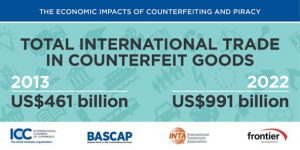Enforcement of Intellectual Property Rights – A Brief Outline
 Posted On
Posted On
Just like other laws require a mechanism of careful administration to reach their full potential in socio-economic terms; Intellectual Property Rights (IPRs) also require a fair deal of enforcement measures to be taken into consideration to ensure equitable implementation. Such measures help curb undermining the efforts of authors and proprietors and ensure even-handed distribution of resources, including those that ensue from Intellectual Property (IP) in the form of innovations and other authored-works.
International Obligation
The Agreement on Trade-related Aspects of Intellectual Property Rights (TRIPS) marked a new beginning in the enforcement game by enunciating minimum standards of such measures to be undertaken by all contracting states to restrict misuse of such property as it is contrary to the practices of fair trade. The two key bases upon which these mechanisms are built are: ‘Most-Favored Nation’ (MFN) and ‘National Treatment.’ The MFN clause ensures that where there is any concession, immunity, privilege, or protection granted to one nation by a host country, the same shall be afforded to all the other countries as well to ensure non-discriminatory practices are not adopted in pursuit of trade. Similarly, National Treatment ensures that a country extends the same facility to other states as it gives its citizen to remove any disparity. Therefore, while making rules of enforcement, the member-state is to ensure that none is given priority over another that may result in unfair trade.
The TRIPS agreement lays down certain ‘general principles,’ which all contracting-states are to reflect in their administrative actions,  civil or criminal. It provides that members shall enable the rights holder to take action against the infringer/potential infringer, and the administration shall pursue fair and equitable measures reflective of due process while deciding on the merits of each case, subjectively. In doing so, fairness and transparency shall be maintained, and where a decision seems unjust to either party, the option of judicial review/appeal shall be made available. The TRIPS Agreement allows the states to take requisite steps in furtherance of undertaking better enforcement measures, which may include civil and criminal remedies alongside custom measures. It states certain ‘provisional measures’ to be adopted as well, which are pre-trial to prevent irreparable damage or destruction of evidence. A prospective provision requires all states to submit legislative measures and issues on enforcement at regular intervals.
civil or criminal. It provides that members shall enable the rights holder to take action against the infringer/potential infringer, and the administration shall pursue fair and equitable measures reflective of due process while deciding on the merits of each case, subjectively. In doing so, fairness and transparency shall be maintained, and where a decision seems unjust to either party, the option of judicial review/appeal shall be made available. The TRIPS Agreement allows the states to take requisite steps in furtherance of undertaking better enforcement measures, which may include civil and criminal remedies alongside custom measures. It states certain ‘provisional measures’ to be adopted as well, which are pre-trial to prevent irreparable damage or destruction of evidence. A prospective provision requires all states to submit legislative measures and issues on enforcement at regular intervals.
| Measures Taken in the EU | Measures Taken in the US |
|---|---|
|
|
Enforcement Measures in India
The government agencies working in furtherance of implementing pro-IP measures as enforced by court orders are meted out by police officials and Local Receivers of the court. For enforcing IP through a sui generis mechanism, some states have their IP Cells in different universities, which totals up to 41 of such cells. The District & Session Judge is the lowest court in such matters. Also, section 11 of the Customs Act, 1962, enables border measures as well.
The enforcement measures may not be at their best; but, they have undoubtedly improved over the years, especially after the  Intellectual Property Rights (Imported Goods) Enforcement Rules, 2007 and later, due to amendment of Trademark Rules in 2017. India has enhanced its administrative capabilities by employing additional examiners and also reducing paper-work by incorporating transparent-online measures. The enforcement measures are kept under check by supervision through governmental bodies like the ‘IPR Promotion and Management’ effort by the Ministry of Commerce.
Intellectual Property Rights (Imported Goods) Enforcement Rules, 2007 and later, due to amendment of Trademark Rules in 2017. India has enhanced its administrative capabilities by employing additional examiners and also reducing paper-work by incorporating transparent-online measures. The enforcement measures are kept under check by supervision through governmental bodies like the ‘IPR Promotion and Management’ effort by the Ministry of Commerce.
Despite the noted additions and improvements made, there are still some issues that India may need to deal with to match necks with first-world nations, which are as follows:
- There is a major pile-up of patent proceedings. The grant of a patent is nothing less than attaining nirvana, which comes with an additional cost and time spent thereon. Where matter goes to trial, the backlog is further increased, which ultimately increases the workload on the judicial machinery.
- The Indian Patent Act facilitates the involvement of subject-matter experts to aid-judicial experts in coming to a fair conclusion due to their lack of technical expertise. However, often they are not appointed, which is detrimental to the interest of the proprietors. The same also affects the standard of decision-making and increases the trial-period by the involvement of higher courts.
- As often complained by stakeholders in the US and EU, the data protection measures concerning pharmaceuticals need further strengthening.
Problems Encountered while Dealing with Enforcement
To briefly understand the kind of problems that states usually come across, let’s consider the following:
- Deficient infrastructure and lack of resources is the key issue in ensuring efficient enforcement. The same stands true for most of the developing and least developed countries (LDC).
- There is a lack of awareness about the significance of IP and enforcement mechanism. Therefore, certain countries have issued educational programs like the US has the American Bar Association Section of Intellectual Property Law and American Intellectual Property Law Association (AIPLA).
- Identification of online and offline mode of infringements are often not treated at an equal footing. China, Ukraine, Russia, Thailand, the Philippines, and Mexico have serious copyright piracy issues, both online and offline.
- Enforcement in pharma-patent poses serious issues since many countries offer restrictive subject-matter criteria for patentability in this domain, which leads to stunted innovation and R&D activity. Here, the approach of health regulatory authorities can also be an added detriment in securing pharma-patents.
- The growth of counterfeit products, specifically those concerning pharma-products with API (Active Pharmaceutical Ingredient), is a serious threat since a lagging enforcement mechanism could lead to potential health risks. For instance, India and China are the largest producers of contraband medicinal products.
- Measures ensuring data protection for regulatory proceedings of pharmaceuticals and plants are majorly lacking in countries like China, Indonesia, India, Mexico, and Argentina.
- There is no proper legislation or even enforcement of any such measures to protect know-how or trade-secrets in countries like India, Russia, and China.
- The MFN and NT principles of trade, as mentioned above, are not often put to practice when dealing with the rights of foreign proprietors.
- Forced or manipulated technology-transfer to ensure ‘local-working’ of the IP also increases the burden on the enforcement machinery.
- Some decisions are influenced by political and economic variables, which may oppose taking serious action against such infringement arising out of piracy.
Finding the Solution to the Problem: The Ultimate Conclusion
Finding an apt solution to curb such unlawful activities through the intervention of upright enforcement mechanisms is very crucial since the impact of IP is far more outreaching than what we may think of ever. It may come as a surprise that many of these activities, like piracy and counterfeiting, are financed through issues as grave as terrorism and drug trafficking. Yes, you read it right, terrorism.
- It is necessary, in the first place, to have administrative machinery in place. The step following such placement of machinery is to ensure that they are aware of the graveness of this problem. And, curbing it is quintessential.
- Proper training and exercises should be conducted, and global cooperation should be witnessed to increase the technical and operative capability of developing as well as LDC, specifically including those in South-East Asia and Latin America.
- Customs authorities should be empowered with adequate power to take action against actual and potential infringement. Their role of supervision should extend to seizures, auditing records, etc.
- There should be multiple redressal options, including provisional measures, injunction, destruction of goods, etc. Also, the recourse of ADR should not be undermined while dealing with IPR issues.
- All infringers should be considered at an equal footing while hunting problem-makers, whether it is the ‘big fish’ in the market or individual enterprises.
- Criminal penalties should correspond to the gravity of the crime. For instance, infringing acts capable of hampering safety, and health should be gravely punishable.
- In the newfound digital age, the mode of prevention should be as sound and advanced in technical as can be to ensure automated and speedy action. The liability of intermediaries should be fixed.
- International cooperation should be facilitated at a global level, including participation through the World Trade Organization (WTO), the World Intellectual Property Organization (WIPO), and the World Customs Organization. ✅ For more visit: https://www.kashishipr.com/
